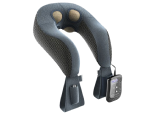What is Sciatic Nerve Pain?
Sciatic nerve pain usually begins in the lower back and can travel through the hips and down one leg, causing inflammation and numbness. Those who suffer from sciatic nerve pain often describe their symptoms as sharp burning sensations or like jolts of electricity. However, sciatic pain can also present as a mild ache, and the severity can range from mild to severe pain. This kind of pain can make many aspects of life more challenging including mobility, social life and work life, to name a few.
Understanding the Sciatic Nerve
The sciatic nerve is the largest and longest nerve in your body, starting in the lower back and running all the way down each leg. It’s formed by several nerve roots that branch out from the spinal cord in the lower back, coming together to create a single, powerful nerve. The sciatic nerve is responsible for sending signals that control the muscles and sensations in your legs, making it essential for walking, standing, and everyday movement. When the sciatic nerve is compressed or irritated, it can trigger sciatica pain—often felt as sharp, shooting pain, tingling, or numbness in the affected leg. Understanding how the sciatic nerve works and its role in your body is key to recognizing sciatica symptoms and finding the right approach to treat sciatica pain.
Causes of Sciatic Nerve Pain
Sciatic nerve pain, or sciatica, can be triggered by a variety of underlying issues. One of the most common causes is a herniated disk in the spine, where the soft center of a spinal disk pushes out and presses on the sciatic nerve. Bone spurs—bony growths that develop on the spine—can also compress the nerve, leading to pain, tingling, and numbness in the affected leg. Another frequent culprit is piriformis syndrome, where the piriformis muscle in the buttocks irritates or pinches the sciatic nerve. Other factors like muscle weakness, poor posture, and prolonged sitting can increase your risk of developing sciatica symptoms.
Techniques & Stretches for Sciatic Pain Relief
Considering how intrusive sciatic pain can be, finding ways to manage it effectively over the long term is crucial. Coming up with a daily pain management routine for sciatic nerve pain can help you continue living your life and doing the things you love while keeping nerve pain out of the way. While some people experience relief within a few weeks with self-care, symptoms lasting more than a month may require medical attention.
To get started, here are seven of our recommended pain relief techniques and stretches for dealing with sciatic nerve pain.
1. Stretch the Hamstrings
While exercise may be the last thing on your mind when pain strikes, stretching and exercising the painful areas as part of your daily routine can help manage your pain more effectively and get you moving again.
Start by trying the Resting Pigeon Pose:
Begin in the starting position on all fours.
-
Outstretch your right leg behind you so that it is parallel to your mat. Bend your left knee and flatten the outside of your left thigh to the ground, stretching your left leg. Your left foot should be in front of your right hip.
-
Lower both hips to the floor and place your hands alongside your hips. Hold for 2-4 breaths.
-
Walk your arms forwards and lean forward from the hips, stretching over your front leg until your forehead rests on the floor. Breathe into the sensations as you stretch your hips and spine.
For a variation, you can place the foot of the affected leg on the opposite knee to target the piriformis muscle.

2. Sleep With a Support Pillow
If you wake up in the morning already in pain, it may be time to address your sleeping position. There are many different ways to sleep with sciatica and feel rested, it’s just a matter of finding the right solution for you. Try sleeping with a supportive pillow between your legs to reduce stress on your back and hamstrings; this can also help stabilize your pelvis to reduce twisting, which can often bring about a flare of pain.
3. Try Massage Therapy
When your mobility is affected by pain, it can often worsen due to a lack of movement. Soothe this stiffness and soreness and start feeling more relaxed with massage therapy. A massage can ease sciatic nerve pain by addressing the pinching or irritation that can trigger shooting pain across the sciatic nerve.

4. Alternate Hot and Cold
Hot and cold packs are commonly used as a conservative treatment for sciatic nerve pain, helping to alleviate discomfort and reduce inflammation. Alternating both hot and cold applications can be ideal for pain that derives from the sciatic nerve. Applying ice packs for 20 minutes can help reduce swelling and provide immediate relief around the sciatic nerve. Follow this with the application of a heat pack to soothe and relax tight muscles.
5. Use TENS Therapy
TENS (Transcutaneous Electrical Nerve Stimulation) is a versatile pain therapy that you can find in DR-HO’S devices including the DR-HO’S Triple Action Back Belt which is a wearable back support with a built in nerve and muscle stimulator that not only supports your back, but also helps to relieve your back pain and sciatica pain. With advanced features like inflatable lumbar support, dual-core compression, and built-in electrotherapy, it stabilizes the back and core muscles, reduces strain, and promotes proper alignment to deliver fast, effective pain relief.
While TENS can’t address the underlying condition, it can be a meaningful sciatic nerve pain remedy that helps you get back to your normal activities and lifestyle.
Learn more about TENS here:
6. Practice Good Posture
Good posture and back support are key in preventing aggravation of the sciatic nerve. With proper back support, you can ensure the spine is correctly aligned and is not putting pressure on discs, joints and nerves. Always ensure you have the right back support to align both your buttocks and lower back into an ergonomic position when seated.
Practice proper posture when seated with your feet situated on the ground and your torso upright at a 90-degree angle. Position any materials or screens at eye levels so that you can keep your head straight. In an ergonomic position, your arms should be able to lie flat on a table in front of you.
7. Seek Physical Therapy
Physical therapists have many techniques/forms of treatment that may help. Sports medicine specialists can also provide targeted exercises and care for sciatic nerve pain, using their expertise to improve function and alleviate symptoms. Treatments can include McKenzie-based mechanical diagnosis and therapy, muscle energy techniques, mobilizations, spinal stabilization and core strengthening exercises, nerve slides/glides, traction and more.

Preventing Future Episodes
Taking steps to prevent future episodes of sciatica pain can make a big difference in your quality of life. Simple self care treatments, such as maintaining good posture and avoiding prolonged sitting, help reduce pressure on the sciatic nerve. Incorporating regular stretching and movement breaks into your day can keep your muscles flexible and your spine healthy. Activities like yoga, pilates, or gentle stretching exercises can strengthen your core and support your back, lowering your risk of sciatica pain returning. Practicing self care, staying active, and making small lifestyle changes are effective treatments to help keep sciatica at bay and support your overall well-being.
Coping with Chronic Pain
Living with chronic sciatica pain can be challenging, but there are many ways to manage symptoms and find relief. Self care treatments like applying a heating pad or hot water bottle to the painful area, or using cold packs to reduce inflammation, can help decrease pain and soothe discomfort. Alternative therapies, such as massage therapy, acupuncture or TENS therapy may also provide additional relief and improve your sense of well-being. Working with a physical therapist or healthcare professional is important for developing a personalized treatment plan that addresses your unique needs. By combining self care, alternative therapies, and professional guidance, you can reduce pain, manage symptoms, and improve your quality of life—even when sciatica pain is persistent.
When in doubt, talk to your doctor.
Keep your preferred healthcare provider updated on new techniques and home remedies you’re trying every step of the way. With an open mind and the motivation to find a reliable pain management routine, you have everything you need to start your journey towards a life with less pain!
Disclaimer: DR-HO'S content is intended for informational purposes only and should not be taken as medical advice. Please consult a certified medical professional for diagnosis and treatment recommendations.










